Business Ethics: A Comprehensive Report on Cross-Cultural Issues
VerifiedAdded on 2020/05/28
|13
|3260
|115
Report
AI Summary
This report delves into the intricacies of business ethics, specifically focusing on cross-cultural communication. It explores various facets, including the impact of cross-cultural communication as a business and ethical issue, the necessity of internal communication capacity, and the true essence of cultural proficiency. The report further examines the effectiveness of focusing on individual differences, the competitive advantages for companies successful in cross-cultural communication, and a comparison of communication styles between India and Australia. It also addresses the negative impact of communication differences, the impact of stereotypical notions on communication, and the accuracy of stereotypical perceptions between India and Australia. The report provides a comprehensive analysis of these issues, offering insights into the challenges and opportunities presented by cross-cultural communication in the business environment.
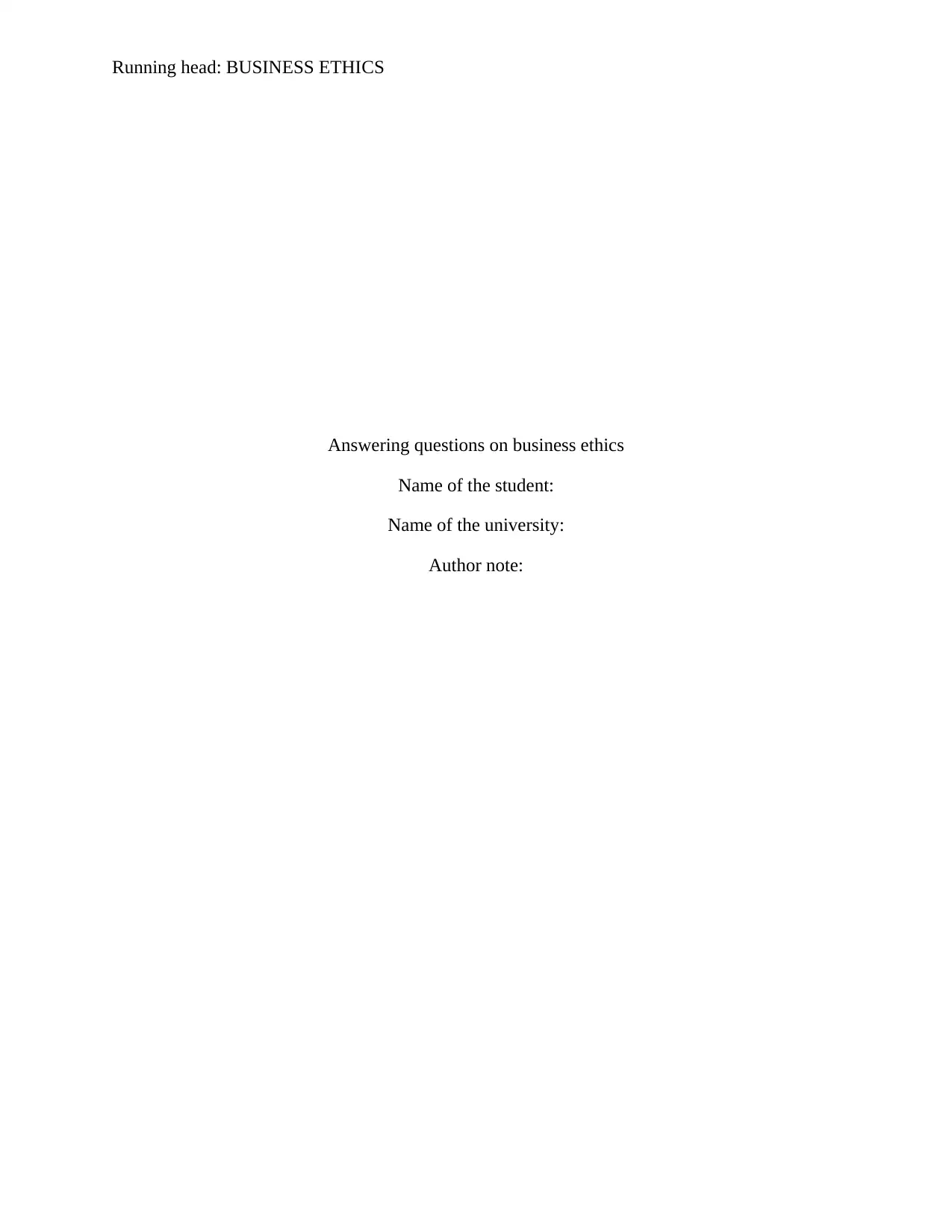
Running head: BUSINESS ETHICS
Answering questions on business ethics
Name of the student:
Name of the university:
Author note:
Answering questions on business ethics
Name of the student:
Name of the university:
Author note:
Paraphrase This Document
Need a fresh take? Get an instant paraphrase of this document with our AI Paraphraser
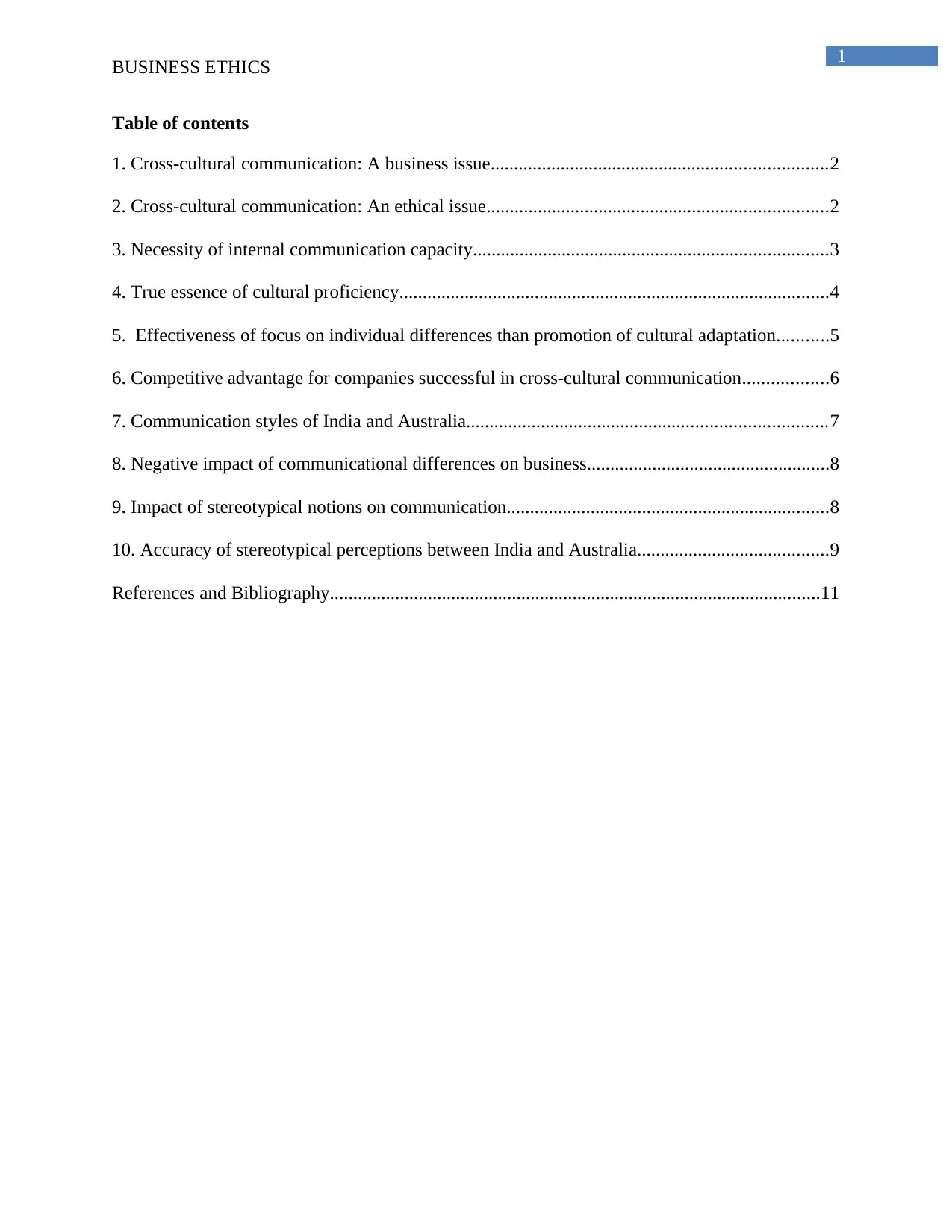
1
BUSINESS ETHICS
Table of contents
1. Cross-cultural communication: A business issue........................................................................2
2. Cross-cultural communication: An ethical issue.........................................................................2
3. Necessity of internal communication capacity............................................................................3
4. True essence of cultural proficiency............................................................................................4
5. Effectiveness of focus on individual differences than promotion of cultural adaptation...........5
6. Competitive advantage for companies successful in cross-cultural communication..................6
7. Communication styles of India and Australia.............................................................................7
8. Negative impact of communicational differences on business....................................................8
9. Impact of stereotypical notions on communication.....................................................................8
10. Accuracy of stereotypical perceptions between India and Australia.........................................9
References and Bibliography.........................................................................................................11
BUSINESS ETHICS
Table of contents
1. Cross-cultural communication: A business issue........................................................................2
2. Cross-cultural communication: An ethical issue.........................................................................2
3. Necessity of internal communication capacity............................................................................3
4. True essence of cultural proficiency............................................................................................4
5. Effectiveness of focus on individual differences than promotion of cultural adaptation...........5
6. Competitive advantage for companies successful in cross-cultural communication..................6
7. Communication styles of India and Australia.............................................................................7
8. Negative impact of communicational differences on business....................................................8
9. Impact of stereotypical notions on communication.....................................................................8
10. Accuracy of stereotypical perceptions between India and Australia.........................................9
References and Bibliography.........................................................................................................11

2
BUSINESS ETHICS
1. Cross-cultural communication: A business issue
Cross-cultural communication results in conglomeration of different cultures. Cross-
cultural communication results in the sharing of preconceived knowledge from one employee to
the other. This knowledge transfer enriches the knowledge, skills and capabilities of the
employees. Moreover, cross-cultural communication brings unity within the employees, leading
to the exposure of collaborative output (Padhi, 2016). These are the positive aspects related to
cross-cultural communication. Viewing the aspect from the negative connotation, cross-cultural
communication results in difference of opinions. Herein lays the appropriateness of the true
meaning of “cross”. This differentiation gives rise to conflicts, harassments and discriminations
breaking the unity. These conflicts compel the companies and organizations to encounter
negative results in terms of the identified goals and objectives. The major drive behind this is
lack of adequate understanding about the regulation of the employees’ performance. This lack
compels the managers to face instances employee turnover, which is an utter loss (Padhi, 2016).
Preference of power during communication creates a negative impact on the employees
about the managers. This type of impression is an obstacle towards extracting productive work
from the employees. This aspect brings behavior into the discussion. Exposure of professional
attitude acts as an opportunity for the employees to become their boss’ favorite.
2. Cross-cultural communication: An ethical issue
In a company or organization, employees belong to different socio-cultural background.
If a company or organization organizes group discussions, it proves beneficial in terms of
enhancing cultural diversity within the workplace. For example, while surveying the employees,
BUSINESS ETHICS
1. Cross-cultural communication: A business issue
Cross-cultural communication results in conglomeration of different cultures. Cross-
cultural communication results in the sharing of preconceived knowledge from one employee to
the other. This knowledge transfer enriches the knowledge, skills and capabilities of the
employees. Moreover, cross-cultural communication brings unity within the employees, leading
to the exposure of collaborative output (Padhi, 2016). These are the positive aspects related to
cross-cultural communication. Viewing the aspect from the negative connotation, cross-cultural
communication results in difference of opinions. Herein lays the appropriateness of the true
meaning of “cross”. This differentiation gives rise to conflicts, harassments and discriminations
breaking the unity. These conflicts compel the companies and organizations to encounter
negative results in terms of the identified goals and objectives. The major drive behind this is
lack of adequate understanding about the regulation of the employees’ performance. This lack
compels the managers to face instances employee turnover, which is an utter loss (Padhi, 2016).
Preference of power during communication creates a negative impact on the employees
about the managers. This type of impression is an obstacle towards extracting productive work
from the employees. This aspect brings behavior into the discussion. Exposure of professional
attitude acts as an opportunity for the employees to become their boss’ favorite.
2. Cross-cultural communication: An ethical issue
In a company or organization, employees belong to different socio-cultural background.
If a company or organization organizes group discussions, it proves beneficial in terms of
enhancing cultural diversity within the workplace. For example, while surveying the employees,
⊘ This is a preview!⊘
Do you want full access?
Subscribe today to unlock all pages.

Trusted by 1+ million students worldwide

3
BUSINESS ETHICS
if the questions are personal, it tends to hurt the individual sentiments of the employees. Along
with this, if most of the questions are religious, it is an attempt to degrade the sanctity and purity
of their culture (Padhi, 2016). If the company or organization imposes restrictions on the dress
code of the employees, it is also an attempt to intervene into their culture, customs and traditions.
Here, achievement of adequate understanding of ethical consideration is a crucial aspect. If a
professor has this understanding, he would be able to indulge in effective communication with
the students and professors from other culture. For this, the professor needs to mix with the
professors and students equally. This needs patience, even if the professors and students expose
differentiation in their communication.
Along with this, if the professor has adequate knowledge regarding the mindset of the
students and professors from other cultures, it would be easier for him to communicate without
any misunderstandings and misinterpretations (Padhi, 2016).
3. Necessity of internal communication capacity
“Recent economic challenges” refer to the competitive rivalry, which aggravates the
complexities of the companies and organizations to sustain their position in the competitive
ambience. In order to sustain the position, the companies and organizations need to develop
communication capacity. Organizing lecture and seminars on diverse topics enables the
personnel to become aware of the fluency of the employees in their linguistic skills. This
assessment is crucial in terms of controlling the external threats. Here, rational approach is
necessary for the managers in terms of regulating the employees’ linguistic performance (Padhi,
2016). “External threat” can be related with the aspect of “threat of substitutes”, intensifying the
rivalry between the brands to grab the power.
BUSINESS ETHICS
if the questions are personal, it tends to hurt the individual sentiments of the employees. Along
with this, if most of the questions are religious, it is an attempt to degrade the sanctity and purity
of their culture (Padhi, 2016). If the company or organization imposes restrictions on the dress
code of the employees, it is also an attempt to intervene into their culture, customs and traditions.
Here, achievement of adequate understanding of ethical consideration is a crucial aspect. If a
professor has this understanding, he would be able to indulge in effective communication with
the students and professors from other culture. For this, the professor needs to mix with the
professors and students equally. This needs patience, even if the professors and students expose
differentiation in their communication.
Along with this, if the professor has adequate knowledge regarding the mindset of the
students and professors from other cultures, it would be easier for him to communicate without
any misunderstandings and misinterpretations (Padhi, 2016).
3. Necessity of internal communication capacity
“Recent economic challenges” refer to the competitive rivalry, which aggravates the
complexities of the companies and organizations to sustain their position in the competitive
ambience. In order to sustain the position, the companies and organizations need to develop
communication capacity. Organizing lecture and seminars on diverse topics enables the
personnel to become aware of the fluency of the employees in their linguistic skills. This
assessment is crucial in terms of controlling the external threats. Here, rational approach is
necessary for the managers in terms of regulating the employees’ linguistic performance (Padhi,
2016). “External threat” can be related with the aspect of “threat of substitutes”, intensifying the
rivalry between the brands to grab the power.
Paraphrase This Document
Need a fresh take? Get an instant paraphrase of this document with our AI Paraphraser
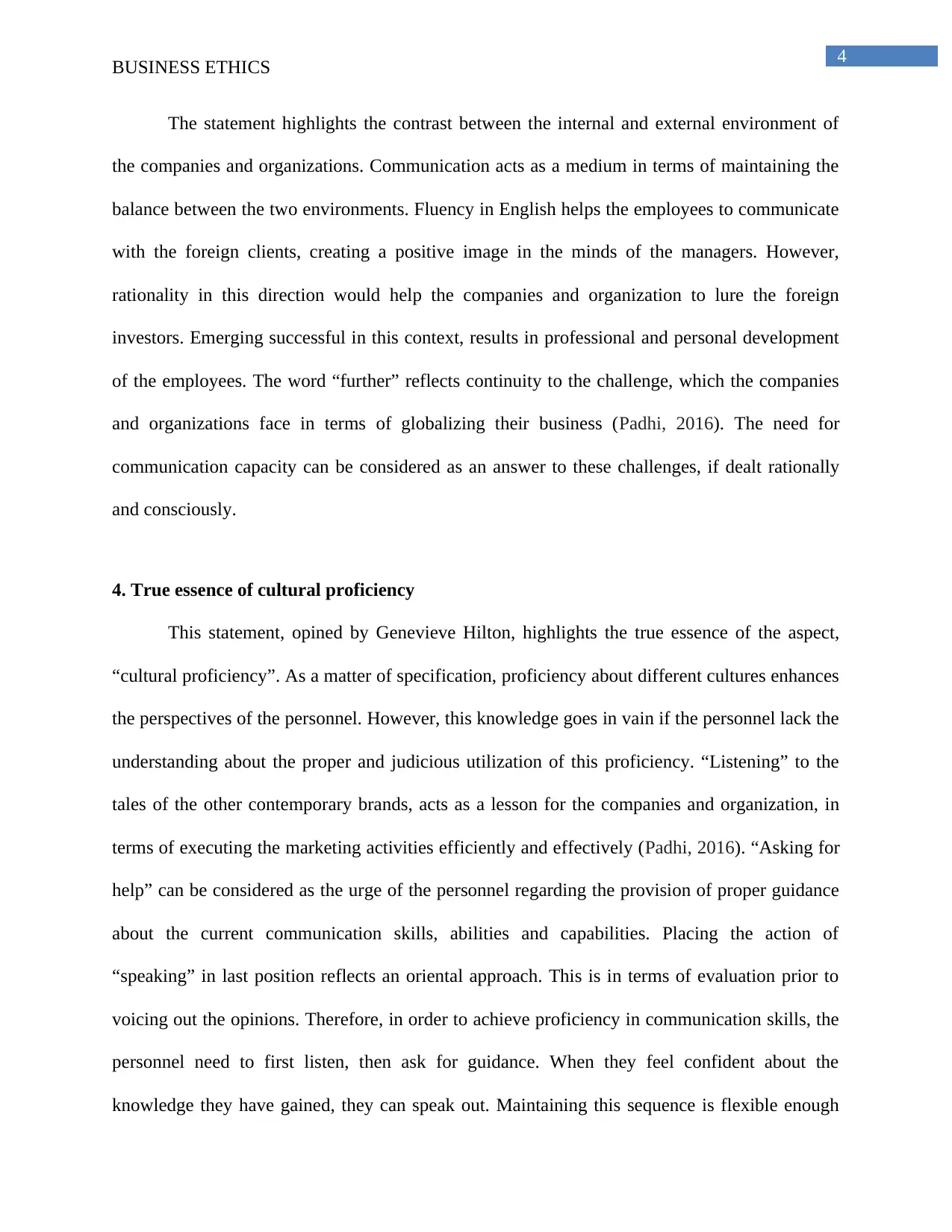
4
BUSINESS ETHICS
The statement highlights the contrast between the internal and external environment of
the companies and organizations. Communication acts as a medium in terms of maintaining the
balance between the two environments. Fluency in English helps the employees to communicate
with the foreign clients, creating a positive image in the minds of the managers. However,
rationality in this direction would help the companies and organization to lure the foreign
investors. Emerging successful in this context, results in professional and personal development
of the employees. The word “further” reflects continuity to the challenge, which the companies
and organizations face in terms of globalizing their business (Padhi, 2016). The need for
communication capacity can be considered as an answer to these challenges, if dealt rationally
and consciously.
4. True essence of cultural proficiency
This statement, opined by Genevieve Hilton, highlights the true essence of the aspect,
“cultural proficiency”. As a matter of specification, proficiency about different cultures enhances
the perspectives of the personnel. However, this knowledge goes in vain if the personnel lack the
understanding about the proper and judicious utilization of this proficiency. “Listening” to the
tales of the other contemporary brands, acts as a lesson for the companies and organization, in
terms of executing the marketing activities efficiently and effectively (Padhi, 2016). “Asking for
help” can be considered as the urge of the personnel regarding the provision of proper guidance
about the current communication skills, abilities and capabilities. Placing the action of
“speaking” in last position reflects an oriental approach. This is in terms of evaluation prior to
voicing out the opinions. Therefore, in order to achieve proficiency in communication skills, the
personnel need to first listen, then ask for guidance. When they feel confident about the
knowledge they have gained, they can speak out. Maintaining this sequence is flexible enough
BUSINESS ETHICS
The statement highlights the contrast between the internal and external environment of
the companies and organizations. Communication acts as a medium in terms of maintaining the
balance between the two environments. Fluency in English helps the employees to communicate
with the foreign clients, creating a positive image in the minds of the managers. However,
rationality in this direction would help the companies and organization to lure the foreign
investors. Emerging successful in this context, results in professional and personal development
of the employees. The word “further” reflects continuity to the challenge, which the companies
and organizations face in terms of globalizing their business (Padhi, 2016). The need for
communication capacity can be considered as an answer to these challenges, if dealt rationally
and consciously.
4. True essence of cultural proficiency
This statement, opined by Genevieve Hilton, highlights the true essence of the aspect,
“cultural proficiency”. As a matter of specification, proficiency about different cultures enhances
the perspectives of the personnel. However, this knowledge goes in vain if the personnel lack the
understanding about the proper and judicious utilization of this proficiency. “Listening” to the
tales of the other contemporary brands, acts as a lesson for the companies and organization, in
terms of executing the marketing activities efficiently and effectively (Padhi, 2016). “Asking for
help” can be considered as the urge of the personnel regarding the provision of proper guidance
about the current communication skills, abilities and capabilities. Placing the action of
“speaking” in last position reflects an oriental approach. This is in terms of evaluation prior to
voicing out the opinions. Therefore, in order to achieve proficiency in communication skills, the
personnel need to first listen, then ask for guidance. When they feel confident about the
knowledge they have gained, they can speak out. Maintaining this sequence is flexible enough

5
BUSINESS ETHICS
for producing positive results in enhancing business communication (Padhi, 2016). Help here can
be related with attending spoken English classes for achieving fluency in the current
communication skills and abilities.
5. Effectiveness of focus on individual differences than promotion of cultural adaptation
Focusing on the individual differences makes the individual aware of their weakness, for
which they lack from the others. Herein lays the appropriateness of the exercise of self-
assessment. Rationality in this assessment helps the individuals in assessing their position amidst
the other cultures. This rationality, in turn, helps in enhancing the preconceived creativity within
the individuals. Training is crucial for the individuals in terms of exposing rational approach
towards refinement of the linguistic skills, abilities and capabilities. Along with this, training
would make the individuals aware of the dynamics of the other cultures (Padhi, 2016). This
knowledge helps the individuals in communication with the people from other socio-cultural
backgrounds, maintaining the sanctity and purity of their cultures. Herein lays the
appropriateness of the aspect, “intercultural communication”. Individual approach is preferred
more in terms of modifying the self-weakness before adopting or mingling with the other
cultures. On the contrary, attempting cross-cultural communication without proper knowledge of
the other cultures would result in negative outcomes. This negativity contradicts the aspect of
innovation, nullifying the hope of refinement in the current communication skills, abilities and
capabilities of the individuals (Padhi, 2016). Making effective use of the learnt skills to
communicate with the personnel of the other socio-cultural backgrounds, results in personal
development, leading towards professional development.
BUSINESS ETHICS
for producing positive results in enhancing business communication (Padhi, 2016). Help here can
be related with attending spoken English classes for achieving fluency in the current
communication skills and abilities.
5. Effectiveness of focus on individual differences than promotion of cultural adaptation
Focusing on the individual differences makes the individual aware of their weakness, for
which they lack from the others. Herein lays the appropriateness of the exercise of self-
assessment. Rationality in this assessment helps the individuals in assessing their position amidst
the other cultures. This rationality, in turn, helps in enhancing the preconceived creativity within
the individuals. Training is crucial for the individuals in terms of exposing rational approach
towards refinement of the linguistic skills, abilities and capabilities. Along with this, training
would make the individuals aware of the dynamics of the other cultures (Padhi, 2016). This
knowledge helps the individuals in communication with the people from other socio-cultural
backgrounds, maintaining the sanctity and purity of their cultures. Herein lays the
appropriateness of the aspect, “intercultural communication”. Individual approach is preferred
more in terms of modifying the self-weakness before adopting or mingling with the other
cultures. On the contrary, attempting cross-cultural communication without proper knowledge of
the other cultures would result in negative outcomes. This negativity contradicts the aspect of
innovation, nullifying the hope of refinement in the current communication skills, abilities and
capabilities of the individuals (Padhi, 2016). Making effective use of the learnt skills to
communicate with the personnel of the other socio-cultural backgrounds, results in personal
development, leading towards professional development.
⊘ This is a preview!⊘
Do you want full access?
Subscribe today to unlock all pages.

Trusted by 1+ million students worldwide

6
BUSINESS ETHICS
6. Competitive advantage for companies successful in cross-cultural communication
It is true that companies, which emerge successful in cross-cultural communication, have
a greater competitive edge. This is because these companies practice time management while
executing the business activities. Most of the time is spent by the personnel on constructing plans
for enhancing efficiency in the business activities. These plans do not include modification of the
internal and external communication skills and abilities. Focus on the management of the
organizational resources helps these companies to provide quality products to the customers
(Padhi, 2016). Maintenance of consistency in seeking innovative ways and means for producing
the products acts assistance for the personnel in terms of adding to the stock of customers.
On the other hand, the companies spending quality time in training the employees on
effect communication are much closer towards penetrating into the foreign markets. This is
because polishing the preconceived communication skills of the employees’ results in the
transformation of the personality of the employees. Providing opportunity to the employees to
speak in the presentations provides them a platform for exercising their communication skills
and abilities. Along with this, organizing question answer sessions after seminars and lectures
enhances the competency and capability of the employees to indulge in effective communication
with the employees of the other cultures (Padhi, 2016).
Therefore, the statement can be contradicted, as the companies with training on
communication are bound to achieve greater competitive edge than those who focus just on the
resources. This negation highlights the fact that attracting the foreign investors with fluent
English conversation possesses direct relationship with the achievement of greater competitive
edge.
BUSINESS ETHICS
6. Competitive advantage for companies successful in cross-cultural communication
It is true that companies, which emerge successful in cross-cultural communication, have
a greater competitive edge. This is because these companies practice time management while
executing the business activities. Most of the time is spent by the personnel on constructing plans
for enhancing efficiency in the business activities. These plans do not include modification of the
internal and external communication skills and abilities. Focus on the management of the
organizational resources helps these companies to provide quality products to the customers
(Padhi, 2016). Maintenance of consistency in seeking innovative ways and means for producing
the products acts assistance for the personnel in terms of adding to the stock of customers.
On the other hand, the companies spending quality time in training the employees on
effect communication are much closer towards penetrating into the foreign markets. This is
because polishing the preconceived communication skills of the employees’ results in the
transformation of the personality of the employees. Providing opportunity to the employees to
speak in the presentations provides them a platform for exercising their communication skills
and abilities. Along with this, organizing question answer sessions after seminars and lectures
enhances the competency and capability of the employees to indulge in effective communication
with the employees of the other cultures (Padhi, 2016).
Therefore, the statement can be contradicted, as the companies with training on
communication are bound to achieve greater competitive edge than those who focus just on the
resources. This negation highlights the fact that attracting the foreign investors with fluent
English conversation possesses direct relationship with the achievement of greater competitive
edge.
Paraphrase This Document
Need a fresh take? Get an instant paraphrase of this document with our AI Paraphraser
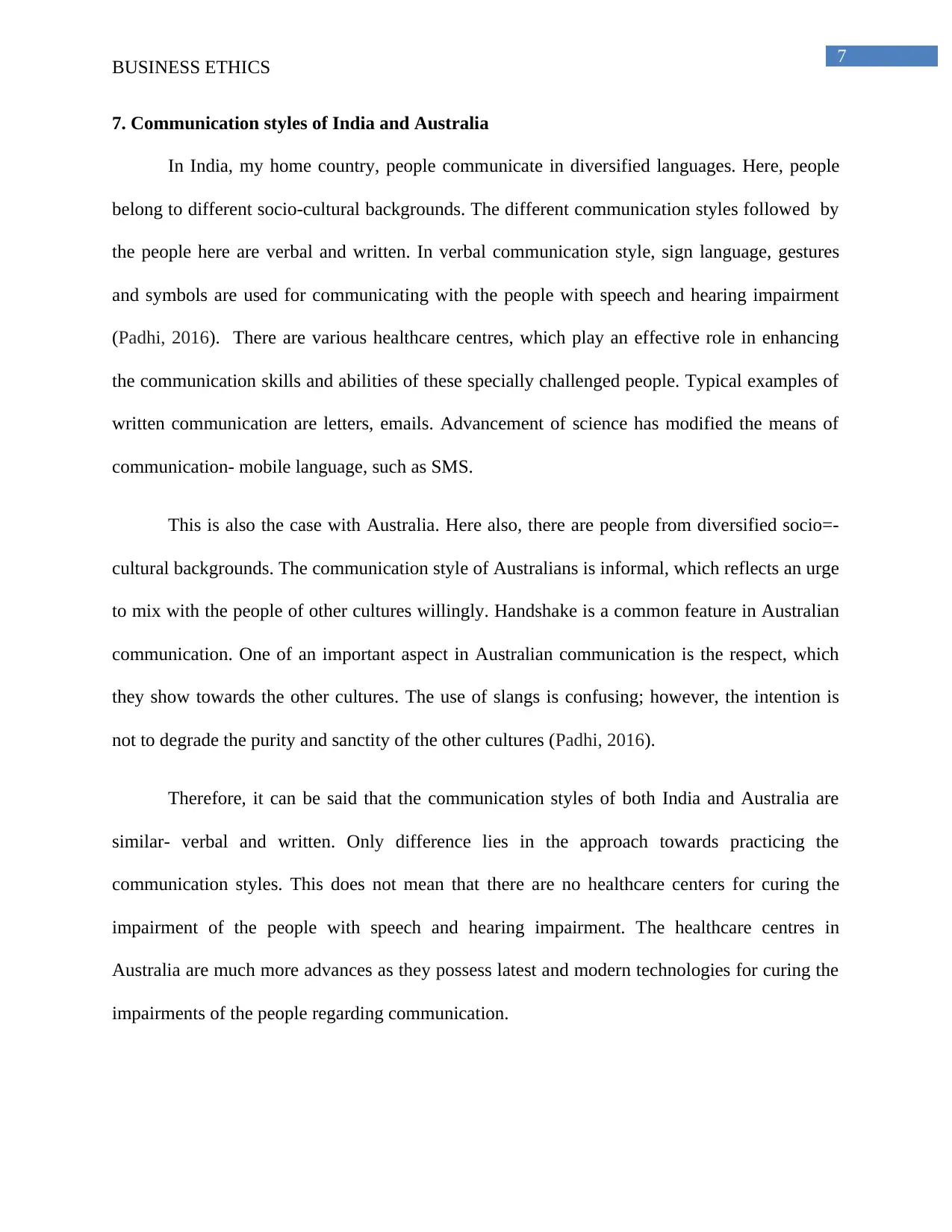
7
BUSINESS ETHICS
7. Communication styles of India and Australia
In India, my home country, people communicate in diversified languages. Here, people
belong to different socio-cultural backgrounds. The different communication styles followed by
the people here are verbal and written. In verbal communication style, sign language, gestures
and symbols are used for communicating with the people with speech and hearing impairment
(Padhi, 2016). There are various healthcare centres, which play an effective role in enhancing
the communication skills and abilities of these specially challenged people. Typical examples of
written communication are letters, emails. Advancement of science has modified the means of
communication- mobile language, such as SMS.
This is also the case with Australia. Here also, there are people from diversified socio=-
cultural backgrounds. The communication style of Australians is informal, which reflects an urge
to mix with the people of other cultures willingly. Handshake is a common feature in Australian
communication. One of an important aspect in Australian communication is the respect, which
they show towards the other cultures. The use of slangs is confusing; however, the intention is
not to degrade the purity and sanctity of the other cultures (Padhi, 2016).
Therefore, it can be said that the communication styles of both India and Australia are
similar- verbal and written. Only difference lies in the approach towards practicing the
communication styles. This does not mean that there are no healthcare centers for curing the
impairment of the people with speech and hearing impairment. The healthcare centres in
Australia are much more advances as they possess latest and modern technologies for curing the
impairments of the people regarding communication.
BUSINESS ETHICS
7. Communication styles of India and Australia
In India, my home country, people communicate in diversified languages. Here, people
belong to different socio-cultural backgrounds. The different communication styles followed by
the people here are verbal and written. In verbal communication style, sign language, gestures
and symbols are used for communicating with the people with speech and hearing impairment
(Padhi, 2016). There are various healthcare centres, which play an effective role in enhancing
the communication skills and abilities of these specially challenged people. Typical examples of
written communication are letters, emails. Advancement of science has modified the means of
communication- mobile language, such as SMS.
This is also the case with Australia. Here also, there are people from diversified socio=-
cultural backgrounds. The communication style of Australians is informal, which reflects an urge
to mix with the people of other cultures willingly. Handshake is a common feature in Australian
communication. One of an important aspect in Australian communication is the respect, which
they show towards the other cultures. The use of slangs is confusing; however, the intention is
not to degrade the purity and sanctity of the other cultures (Padhi, 2016).
Therefore, it can be said that the communication styles of both India and Australia are
similar- verbal and written. Only difference lies in the approach towards practicing the
communication styles. This does not mean that there are no healthcare centers for curing the
impairment of the people with speech and hearing impairment. The healthcare centres in
Australia are much more advances as they possess latest and modern technologies for curing the
impairments of the people regarding communication.
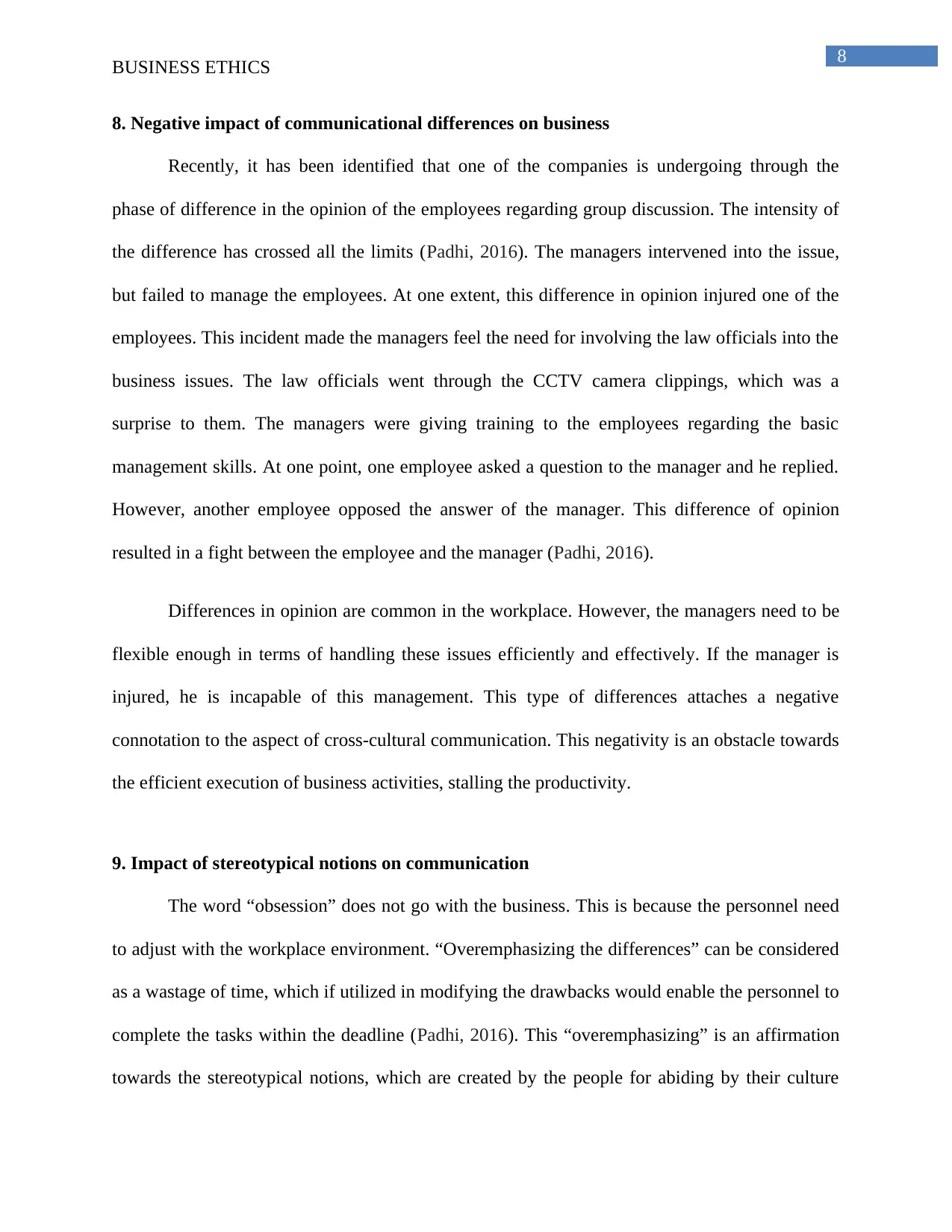
8
BUSINESS ETHICS
8. Negative impact of communicational differences on business
Recently, it has been identified that one of the companies is undergoing through the
phase of difference in the opinion of the employees regarding group discussion. The intensity of
the difference has crossed all the limits (Padhi, 2016). The managers intervened into the issue,
but failed to manage the employees. At one extent, this difference in opinion injured one of the
employees. This incident made the managers feel the need for involving the law officials into the
business issues. The law officials went through the CCTV camera clippings, which was a
surprise to them. The managers were giving training to the employees regarding the basic
management skills. At one point, one employee asked a question to the manager and he replied.
However, another employee opposed the answer of the manager. This difference of opinion
resulted in a fight between the employee and the manager (Padhi, 2016).
Differences in opinion are common in the workplace. However, the managers need to be
flexible enough in terms of handling these issues efficiently and effectively. If the manager is
injured, he is incapable of this management. This type of differences attaches a negative
connotation to the aspect of cross-cultural communication. This negativity is an obstacle towards
the efficient execution of business activities, stalling the productivity.
9. Impact of stereotypical notions on communication
The word “obsession” does not go with the business. This is because the personnel need
to adjust with the workplace environment. “Overemphasizing the differences” can be considered
as a wastage of time, which if utilized in modifying the drawbacks would enable the personnel to
complete the tasks within the deadline (Padhi, 2016). This “overemphasizing” is an affirmation
towards the stereotypical notions, which are created by the people for abiding by their culture
BUSINESS ETHICS
8. Negative impact of communicational differences on business
Recently, it has been identified that one of the companies is undergoing through the
phase of difference in the opinion of the employees regarding group discussion. The intensity of
the difference has crossed all the limits (Padhi, 2016). The managers intervened into the issue,
but failed to manage the employees. At one extent, this difference in opinion injured one of the
employees. This incident made the managers feel the need for involving the law officials into the
business issues. The law officials went through the CCTV camera clippings, which was a
surprise to them. The managers were giving training to the employees regarding the basic
management skills. At one point, one employee asked a question to the manager and he replied.
However, another employee opposed the answer of the manager. This difference of opinion
resulted in a fight between the employee and the manager (Padhi, 2016).
Differences in opinion are common in the workplace. However, the managers need to be
flexible enough in terms of handling these issues efficiently and effectively. If the manager is
injured, he is incapable of this management. This type of differences attaches a negative
connotation to the aspect of cross-cultural communication. This negativity is an obstacle towards
the efficient execution of business activities, stalling the productivity.
9. Impact of stereotypical notions on communication
The word “obsession” does not go with the business. This is because the personnel need
to adjust with the workplace environment. “Overemphasizing the differences” can be considered
as a wastage of time, which if utilized in modifying the drawbacks would enable the personnel to
complete the tasks within the deadline (Padhi, 2016). This “overemphasizing” is an affirmation
towards the stereotypical notions, which are created by the people for abiding by their culture
⊘ This is a preview!⊘
Do you want full access?
Subscribe today to unlock all pages.

Trusted by 1+ million students worldwide
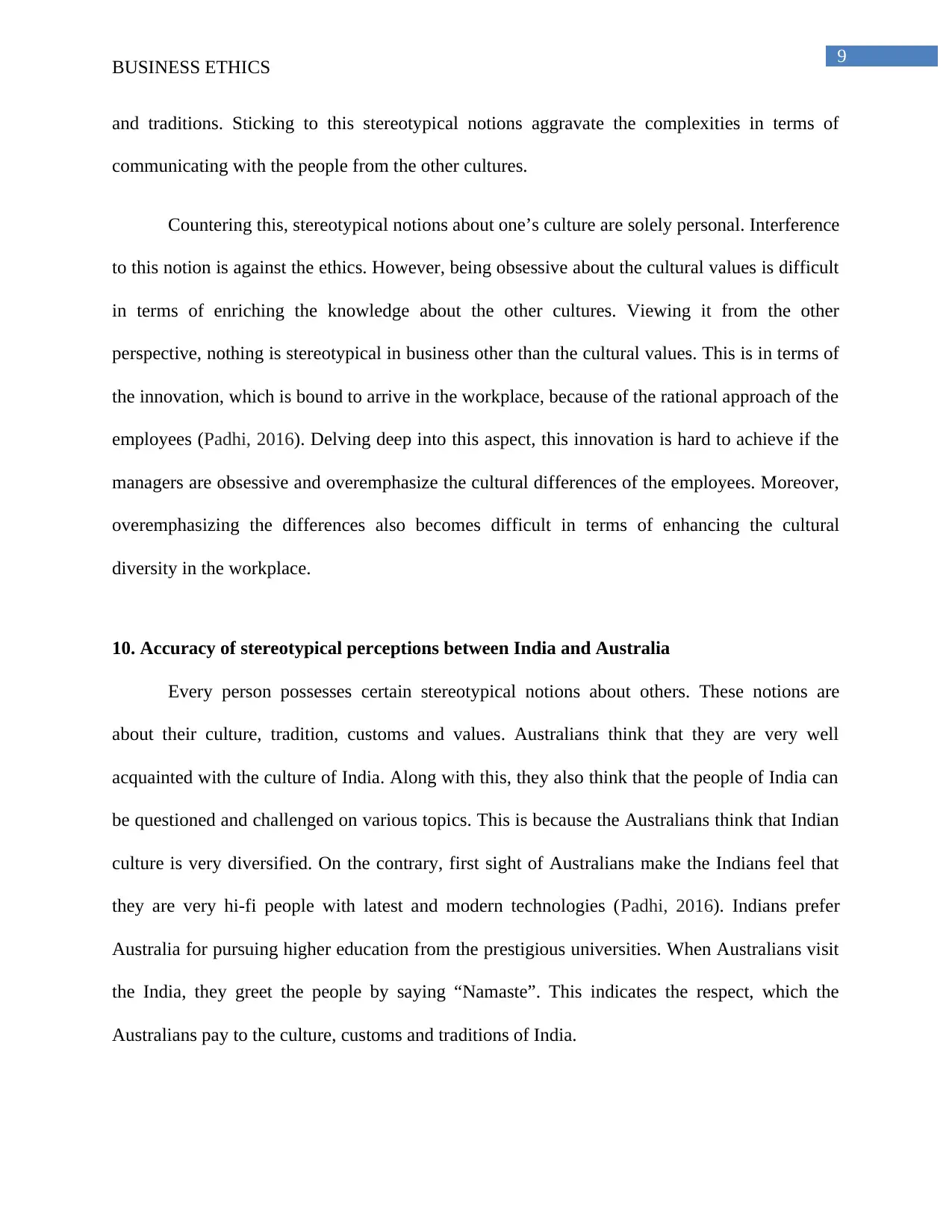
9
BUSINESS ETHICS
and traditions. Sticking to this stereotypical notions aggravate the complexities in terms of
communicating with the people from the other cultures.
Countering this, stereotypical notions about one’s culture are solely personal. Interference
to this notion is against the ethics. However, being obsessive about the cultural values is difficult
in terms of enriching the knowledge about the other cultures. Viewing it from the other
perspective, nothing is stereotypical in business other than the cultural values. This is in terms of
the innovation, which is bound to arrive in the workplace, because of the rational approach of the
employees (Padhi, 2016). Delving deep into this aspect, this innovation is hard to achieve if the
managers are obsessive and overemphasize the cultural differences of the employees. Moreover,
overemphasizing the differences also becomes difficult in terms of enhancing the cultural
diversity in the workplace.
10. Accuracy of stereotypical perceptions between India and Australia
Every person possesses certain stereotypical notions about others. These notions are
about their culture, tradition, customs and values. Australians think that they are very well
acquainted with the culture of India. Along with this, they also think that the people of India can
be questioned and challenged on various topics. This is because the Australians think that Indian
culture is very diversified. On the contrary, first sight of Australians make the Indians feel that
they are very hi-fi people with latest and modern technologies (Padhi, 2016). Indians prefer
Australia for pursuing higher education from the prestigious universities. When Australians visit
the India, they greet the people by saying “Namaste”. This indicates the respect, which the
Australians pay to the culture, customs and traditions of India.
BUSINESS ETHICS
and traditions. Sticking to this stereotypical notions aggravate the complexities in terms of
communicating with the people from the other cultures.
Countering this, stereotypical notions about one’s culture are solely personal. Interference
to this notion is against the ethics. However, being obsessive about the cultural values is difficult
in terms of enriching the knowledge about the other cultures. Viewing it from the other
perspective, nothing is stereotypical in business other than the cultural values. This is in terms of
the innovation, which is bound to arrive in the workplace, because of the rational approach of the
employees (Padhi, 2016). Delving deep into this aspect, this innovation is hard to achieve if the
managers are obsessive and overemphasize the cultural differences of the employees. Moreover,
overemphasizing the differences also becomes difficult in terms of enhancing the cultural
diversity in the workplace.
10. Accuracy of stereotypical perceptions between India and Australia
Every person possesses certain stereotypical notions about others. These notions are
about their culture, tradition, customs and values. Australians think that they are very well
acquainted with the culture of India. Along with this, they also think that the people of India can
be questioned and challenged on various topics. This is because the Australians think that Indian
culture is very diversified. On the contrary, first sight of Australians make the Indians feel that
they are very hi-fi people with latest and modern technologies (Padhi, 2016). Indians prefer
Australia for pursuing higher education from the prestigious universities. When Australians visit
the India, they greet the people by saying “Namaste”. This indicates the respect, which the
Australians pay to the culture, customs and traditions of India.
Paraphrase This Document
Need a fresh take? Get an instant paraphrase of this document with our AI Paraphraser

10
BUSINESS ETHICS
These notions can be considered as accurate in terms of enriching knowledge regarding
the other cultures. However, in terms of communication, preference to these notions hinders the
aspect of cross-cultural communication. Over-emphasizing these stereotypical notions tends to
produce negative results in terms of execution of the business activities.
Viewing it from the other perspective, stereotypical notions about other cultures act as an
obstacle in mixing with the people. This hindrance aggravates the complexities in terms of
organizing group discussions between the employees (Padhi, 2016).
BUSINESS ETHICS
These notions can be considered as accurate in terms of enriching knowledge regarding
the other cultures. However, in terms of communication, preference to these notions hinders the
aspect of cross-cultural communication. Over-emphasizing these stereotypical notions tends to
produce negative results in terms of execution of the business activities.
Viewing it from the other perspective, stereotypical notions about other cultures act as an
obstacle in mixing with the people. This hindrance aggravates the complexities in terms of
organizing group discussions between the employees (Padhi, 2016).
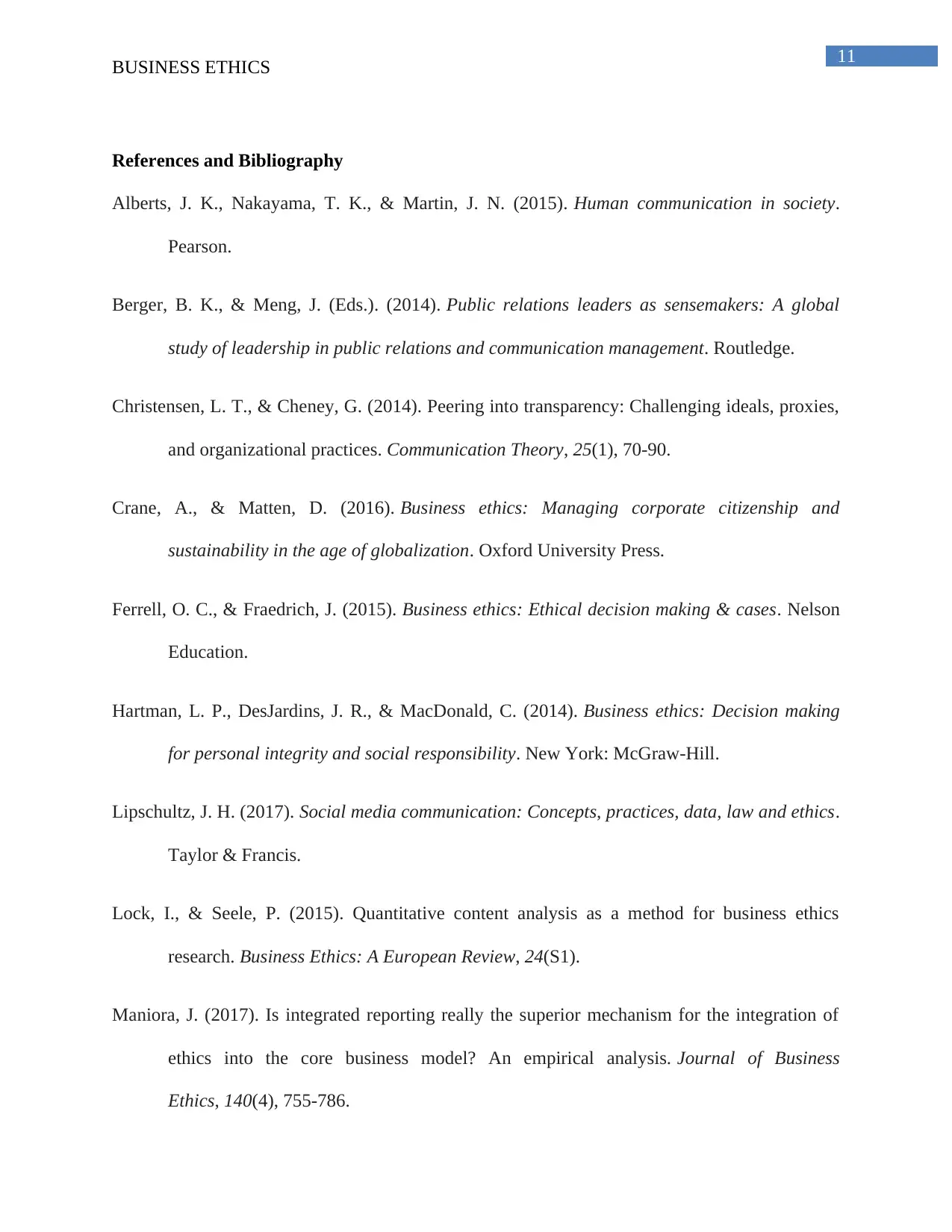
11
BUSINESS ETHICS
References and Bibliography
Alberts, J. K., Nakayama, T. K., & Martin, J. N. (2015). Human communication in society.
Pearson.
Berger, B. K., & Meng, J. (Eds.). (2014). Public relations leaders as sensemakers: A global
study of leadership in public relations and communication management. Routledge.
Christensen, L. T., & Cheney, G. (2014). Peering into transparency: Challenging ideals, proxies,
and organizational practices. Communication Theory, 25(1), 70-90.
Crane, A., & Matten, D. (2016). Business ethics: Managing corporate citizenship and
sustainability in the age of globalization. Oxford University Press.
Ferrell, O. C., & Fraedrich, J. (2015). Business ethics: Ethical decision making & cases. Nelson
Education.
Hartman, L. P., DesJardins, J. R., & MacDonald, C. (2014). Business ethics: Decision making
for personal integrity and social responsibility. New York: McGraw-Hill.
Lipschultz, J. H. (2017). Social media communication: Concepts, practices, data, law and ethics.
Taylor & Francis.
Lock, I., & Seele, P. (2015). Quantitative content analysis as a method for business ethics
research. Business Ethics: A European Review, 24(S1).
Maniora, J. (2017). Is integrated reporting really the superior mechanism for the integration of
ethics into the core business model? An empirical analysis. Journal of Business
Ethics, 140(4), 755-786.
BUSINESS ETHICS
References and Bibliography
Alberts, J. K., Nakayama, T. K., & Martin, J. N. (2015). Human communication in society.
Pearson.
Berger, B. K., & Meng, J. (Eds.). (2014). Public relations leaders as sensemakers: A global
study of leadership in public relations and communication management. Routledge.
Christensen, L. T., & Cheney, G. (2014). Peering into transparency: Challenging ideals, proxies,
and organizational practices. Communication Theory, 25(1), 70-90.
Crane, A., & Matten, D. (2016). Business ethics: Managing corporate citizenship and
sustainability in the age of globalization. Oxford University Press.
Ferrell, O. C., & Fraedrich, J. (2015). Business ethics: Ethical decision making & cases. Nelson
Education.
Hartman, L. P., DesJardins, J. R., & MacDonald, C. (2014). Business ethics: Decision making
for personal integrity and social responsibility. New York: McGraw-Hill.
Lipschultz, J. H. (2017). Social media communication: Concepts, practices, data, law and ethics.
Taylor & Francis.
Lock, I., & Seele, P. (2015). Quantitative content analysis as a method for business ethics
research. Business Ethics: A European Review, 24(S1).
Maniora, J. (2017). Is integrated reporting really the superior mechanism for the integration of
ethics into the core business model? An empirical analysis. Journal of Business
Ethics, 140(4), 755-786.
⊘ This is a preview!⊘
Do you want full access?
Subscribe today to unlock all pages.

Trusted by 1+ million students worldwide
1 out of 13
Related Documents
Your All-in-One AI-Powered Toolkit for Academic Success.
+13062052269
info@desklib.com
Available 24*7 on WhatsApp / Email
![[object Object]](/_next/static/media/star-bottom.7253800d.svg)
Unlock your academic potential
Copyright © 2020–2025 A2Z Services. All Rights Reserved. Developed and managed by ZUCOL.





